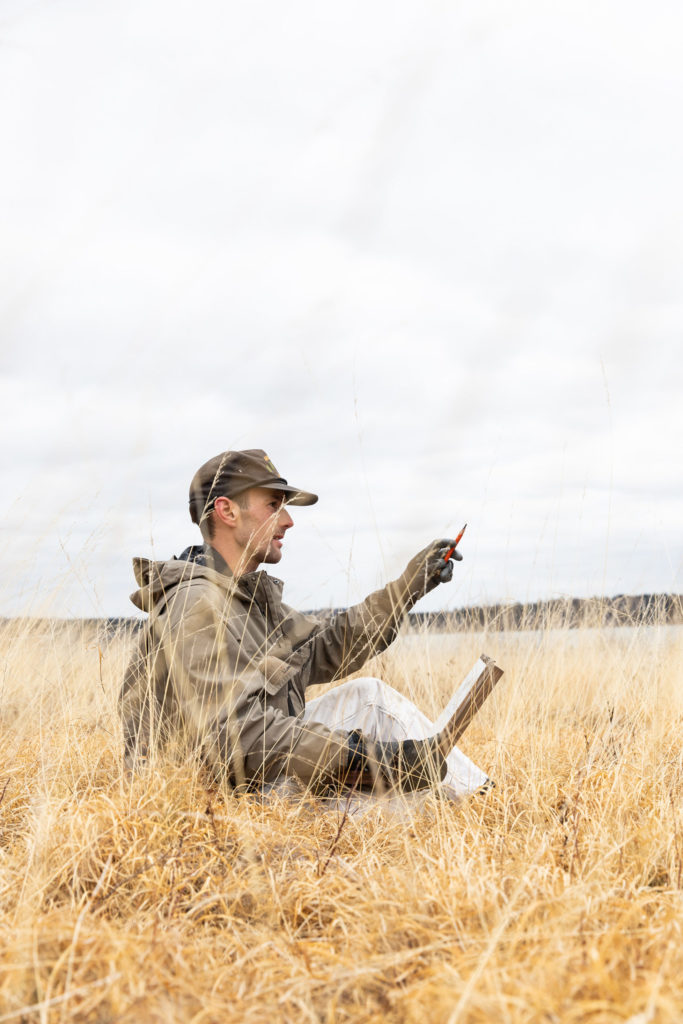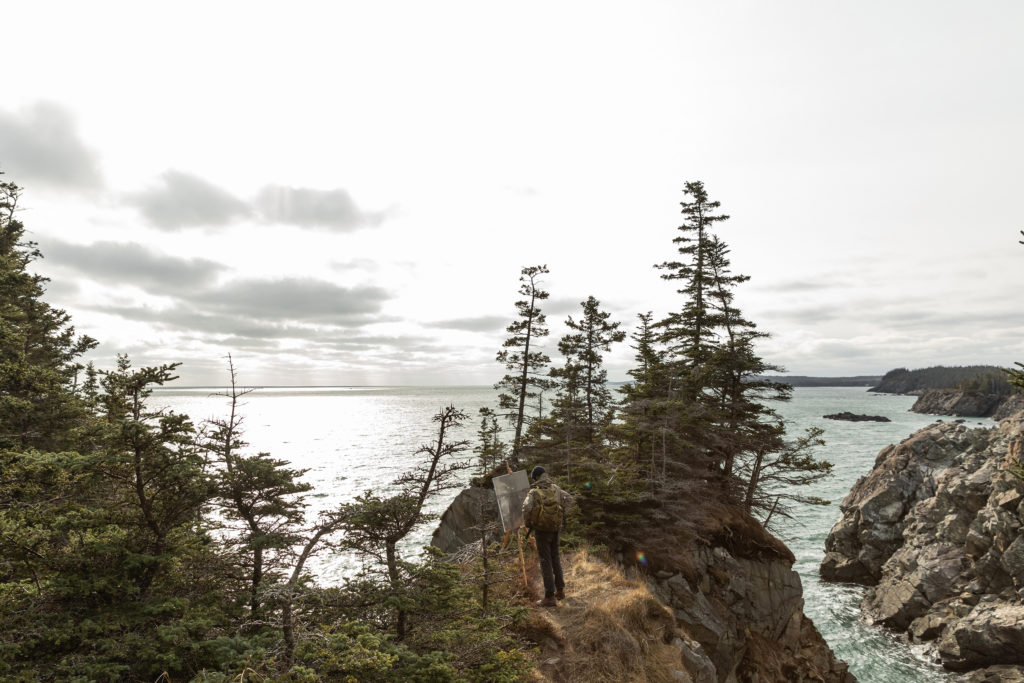The Artist Painting Maine’s Coast
Hiking and kayaking up and down Maine’s coast with his easel in tow, painter Timothy Wilson captures the state’s dramatic landscape.

The Artist Painting Maine’s Coast
Timothy Wilson is hiking and kayaking Maine Coast Heritage Trust’s preserves with an easel in tow.
by Katy Kelleher
Photography by Greta Rybus
Issue: June 2021
Artist Timothy Wilson grew up in Maine, but until recently he had never hiked the cliffs of the Bold Coast or traversed the seaweed-slick rocks near Boot Head. This isn’t that uncommon; trips “way downeast” take time and energy and a full tank of gas. There are easier places to paint. But when Maine Coast Heritage Trust approached Wilson about a collaboration to explore and paint its protected lands, Wilson jumped at the chance. He wanted to see more of his home state—really see it. He wanted to spend time getting to know the landscape on a deeper, more intimate and intuitive level.
He was also hoping to create a body of work that would be shown in person, and that would help raise money for the land conservation organization (thus enabling the nonprofit to keep expanding public access to wild places). The work was already underway when their exhibition plans had to be put on hold due to the global pandemic. “We could have scrapped the project,” Wilson says. “But neither Maine Coast Heritage Trust nor myself wanted to give up on it.” It was still safe for Wilson to paint outdoors, though, and over the past two years, Wilson has visited over a dozen of the nonprofit’s preserves all up and down the coast, from the islands of Broad Sound to the bogs of Trescott and Lubec, as part of his “Maine Coast Sojourn.” While he hasn’t been able to stay overnight at every location, Wilson is committed to experiencing the preserved lands as a visitor might. He doesn’t drop in, snap a photo, then go paint it back at the studio. He kayaks to islands alone, taking an easel setup in his boat. He hikes with all his painting supplies out to the cliffs to spend hours observing. He sleeps on the ground. He waits silently while deer graze nearby, holding his breath so as to not startle them.

Wilson hikes through the pines. Sometimes, he likes to imagine the painters who came before him. “Think of the 1800s artists and all their gear,” he says. “They must have been stronger folk than I.”
Sunrise at Woodward Point Preserve in Brunswick. “I’m a sucker for the liminal spaces, like very early morning,” he says.

“I feel more integrated into the environment when I am involved in getting there,” Wilson says. “There’s a muscle memory. There’s the sensation of the waves and the air hitting me. It’s an exertion. I become engaged in a way that feels more immersive.” Although Wilson says he is not religious, he does feel a “spiritual element” seeping into his work on the Maine coast. “It’s not just about finding a beautiful scene,” he says. “I can find beauty in anything. But it won’t necessarily be deep to me. I might not empathize with it.” He finds it easier to feel connected to the land, and to the work, when he is stretching his legs and using his muscles. There’s something about the physicality of it, and the waiting, the breathing, the watching. It all comes together to create a deep sense of place that he then translates into brushstrokes on canvas.
Wilson’s work isn’t photorealistic. You won’t necessarily recognize this trail or that boulder. He’s not looking to depict iconic Maine scenes, but rather the vastness of the ocean and the looming shadows of the sky. “People consider my work very dark or gloomy,” he says. “I paint a lot of overcast, rainy skies. I’ve realized that it’s dramatic, and there’s a romance to the weather that I connect with.” He says he enjoys sunny days at the beach “as much as anyone,” but it’s the cloudy days that awaken his artistic self. “It creates a timelessness, a sense of limbo,” he explains. “There’s an Irish term, the ‘thin veil.’ It’s a place where there’s a divide between worlds.” The cloudy, craggy Maine coast reminds him of all the folklore he’s read, all the stories he’s internalized. When he’s painting, he tries to call up these tales and put them into the work. And New England has plenty of tales. “I think about all the things that happened here, all the witch trials, the settlers, the Indigenous people,” he says. “I think of how the people must have felt back then. The stories they told each other.” Folklore, he believes, comes from feelings of confusion, wonder, and fear. This comes through in his paintings—they’re not just gloomy. Some are tense and ominous; others are still, waiting, pensive.

Wilson plans to continue painting the Maine Coast Heritage Trust’s preserved estuaries, woods, and beaches. The organization has over 150 locations under their stewardship, so it’s unlikely that Wilson will visit every one. But he has selected areas that are representative of the greater whole, and using social media, he’s been able to share his travels and progress online. “In a way, I’m glad it all worked out this way,” says Sophie Nelson of Maine Coast Heritage Trust. “Along with Timothy, so many people discovered MCHT’s conserved lands during the pandemic. Those places provided inspiration and relief when we needed it most, and Timothy’s art and documentation of the Sojourn on Instagram felt all the more relevant.”
Going forward, Wilson says he plans to incorporate some evidence of civilization into his paintings, which could further help viewers connect with his work. “For most of this project, I haven’t painted buildings. It will be interesting to paint in a place with signs of humanity. Often, I remove buildings from my landscapes. But I’m going out to some of the farther islands, and I want to show the buildings there.” Wilson grew up inland in West Lebanon on some 60 acres of woodland surrounded by a stone wall. His father was a woodworker, and his mother “tinkered.” His parents and their work gave him an appreciation for a certain kind of local structure. “I remember being surrounded by these beautiful aged buildings that were crumbling but still somehow statuesque. I’m so glad I had the childhood I had. It’s a fleeting thing to be able to experience these days.”
It’s not set in stone, but it appears likely that Wilson will be able to have his exhibition sometime this year. (Keep on eye on Cove Street Arts this September.) “Second year in, and we still have plans to do it. I’m still hoping,” he says. Something changes, he explains, when you see the texture and scale of a work of art without the mediation of a computer screen. “I want people to be able to experience it how I experienced it,” he says. For now, there are still the trails, still the islands, still the coast. The land is still there, waiting.

Composing in the grass of Machiasport.
Discovering parts so far north up the coast has been a revelation for Wilson. Although he grew up in Maine, he hadn’t spent much time downeast.






